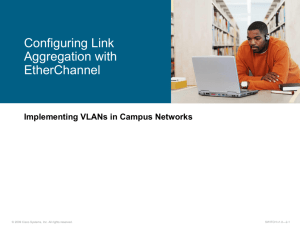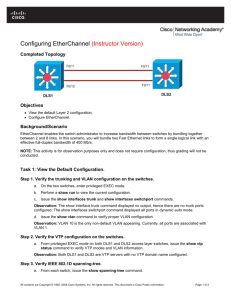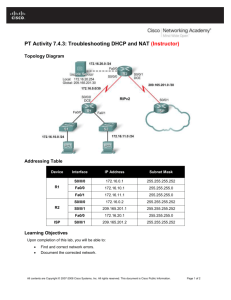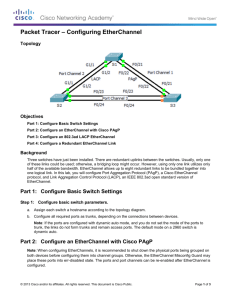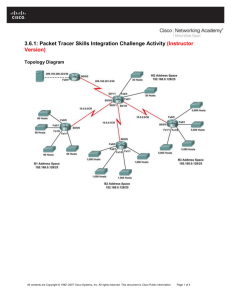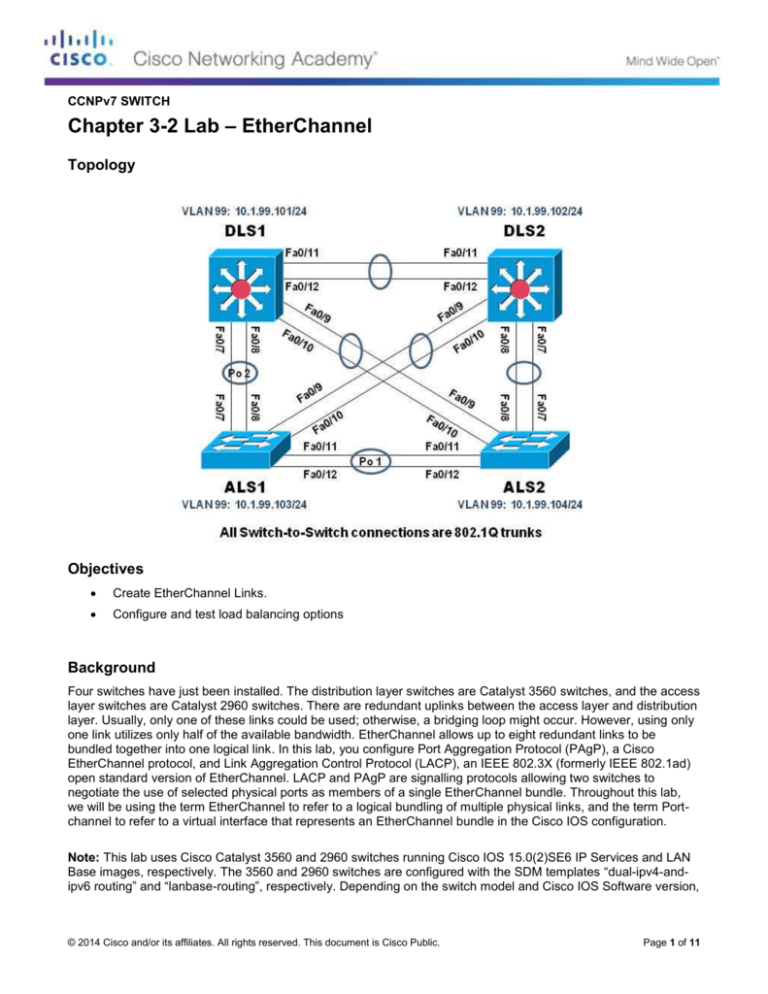
CCNPv7 SWITCH
Chapter 3-2 Lab – EtherChannel
Topology
Objectives
Create EtherChannel Links.
Configure and test load balancing options
Background
Four switches have just been installed. The distribution layer switches are Catalyst 3560 switches, and the access
layer switches are Catalyst 2960 switches. There are redundant uplinks between the access layer and distribution
layer. Usually, only one of these links could be used; otherwise, a bridging loop might occur. However, using only
one link utilizes only half of the available bandwidth. EtherChannel allows up to eight redundant links to be
bundled together into one logical link. In this lab, you configure Port Aggregation Protocol (PAgP), a Cisco
EtherChannel protocol, and Link Aggregation Control Protocol (LACP), an IEEE 802.3X (formerly IEEE 802.1ad)
open standard version of EtherChannel. LACP and PAgP are signalling protocols allowing two switches to
negotiate the use of selected physical ports as members of a single EtherChannel bundle. Throughout this lab,
we will be using the term EtherChannel to refer to a logical bundling of multiple physical links, and the term Portchannel to refer to a virtual interface that represents an EtherChannel bundle in the Cisco IOS configuration.
Note: This lab uses Cisco Catalyst 3560 and 2960 switches running Cisco IOS 15.0(2)SE6 IP Services and LAN
Base images, respectively. The 3560 and 2960 switches are configured with the SDM templates “dual-ipv4-andipv6 routing” and “lanbase-routing”, respectively. Depending on the switch model and Cisco IOS Software version,
© 2014 Cisco and/or its affiliates. All rights reserved. This document is Cisco Public.
Page 1 of 11
CCNPv7 SWITCH: Lab 3-2 – EtherChannel
the commands available and output produced might vary from what is shown in this lab. Catalyst 3650 switches
(running any Cisco IOS XE release) and Catalyst 2960-Plus switches (running any comparable Cisco IOS image)
can be used in place of the Catalyst 3560 switches and the Catalyst 2960 switches.
Required Resources
2 Cisco 2960 with the Cisco IOS Release 15.0(2)SE6 C2960-LANBASEK9-M or comparable
2 Cisco 3560v2 with the Cisco IOS Release 15.0(2)SE6 C3560-IPSERVICESK9-M or comparable
Computer with terminal emulation software
Ethernet and console cables
Part 1: Configure EtherChannel Links
Step 1:
Prepare the switches for the lab
The instructions in this lab assume that the switches are running using the final configuration from Lab 2-1
"Static VLANs, Trunking, and VTP".
Step 2: Configure an EtherChannel with Cisco PAgP.
The first EtherChannel created for this lab aggregates interfaces Fa0/11 and Fa0/12 between ALS1 and
ALS2. Make sure that you have a trunk link active for those two links with the show interfaces trunk
command.
ALS1# show interfaces trunk
Port
Mode
Fa0/7
on
Fa0/8
on
Fa0/9
on
Fa0/10
on
Fa0/11
on
Fa0/12
on
<output omitted>
Encapsulation
802.1q
802.1q
802.1q
802.1q
802.1q
802.1q
Status
trunking
trunking
trunking
trunking
trunking
trunking
Native vlan
666
666
666
666
666
666
Note: When configuring EtherChannels, it can be helpful to shutdown the physical interfaces being grouped
on both devices before configuring them into channel groups. Otherwise, the EtherChannel Misconfig Guard
may place these interfaces into err-disabled state. The interfaces and port channel can be re-enabled after
the EtherChannel is configured.
On ALS1, bundle interfaces Fa0/11 and Fa0/12 under the Port-Channel 1 interface with the channel-group
1 mode desirable command. The mode desirable option indicates that you want the switch to actively
negotiate to form a PAgP link. The Port-Channel interface numbers are locally-significant only. On the 2960,
the number can be anything between 1 and 6, and they do not have to match end to end. If it is possible, use
the same number on both sides of a port-channel so that coordinating troubleshooting is less complicated. At
the very least, clearly document the configuration.
ALS1(config)# interface range f0/11-12
ALS1(config-if-range)# shutdown
<output omitted - interfaces logged as shutting down>
ALS1(config-if-range)# channel-group 1 mode desirable
© 2014 Cisco and/or its affiliates. All rights reserved. This document is Cisco Public.
Page 2 of 11
CCNPv7 SWITCH: Lab 3-2 – EtherChannel
Creating a port-channel interface Port-channel 1
ALS1(config-if-range)# no shutdown
<output omitted - interfaces logged as coming up>
ALS1(config-if-range)# exit
ALS1(config)#
<the following output is seen after ALS2 configuration is complete>
*Mar 1 00:14:01.570: %LINK-3-UPDOWN: Interface Port-channel1, changed state
to up
*Mar 1 00:14:02.576: %LINEPROTO-5-UPDOWN: Line protocol on Interface Portchannel1, changed state to up
After you configure an EtherChannel, a virtual Port-Channel interface is created automatically that represents
a logical link consisting of the bundled physical interfaces. The Port-channel interface will automatically inherit
the configuration of the first physical interface that was added to the EtherChannel. All configuration changes
applied to the Port-channel interface will then apply to all the physical ports bundled under this interface.
The configuration of the physical interfaces that are bundled into an EtherChannel must be consistent.
Otherwise, the bundle may never form or individual links in the bundle may be suspended. Once physical
interfaces are added to the EtherChannel bundle, the administrator should not make any configuration
changes directly to the physical interfaces. Any necessary adjustments should be made to the appropriate
Port-Channel interface.
Therefore, unless explicitly asked to do so in these labs, after physical ports have been bundled in an
EtherChannel, apply all further commands to the corresponding Port-channel interface only.
Before configuring the EtherChannel bundle on ALS2, issue the command show etherchannel summary
on ALS1 and notice the status of both the bundle and the individual interfaces:
ALS1# show etherchannel
Flags: D - down
I - stand-alone
H - Hot-standby
R - Layer3
U - in use
M
u
w
d
-
summary
P - bundled in port-channel
s - suspended
(LACP only)
S - Layer2
f - failed to allocate aggregator
not in use, minimum links not met
unsuitable for bundling
waiting to be aggregated
default port
Number of channel-groups in use: 1
Number of aggregators:
1
Group Port-channel Protocol
Ports
------+-------------+-----------+----------------------------------------------1
Po1(SD)
PAgP
Fa0/11(I)
Fa0/12(I)
ALS1#
PAgP is preventing the bundle from forming because the other end is not speaking the PAgP protocol.
© 2014 Cisco and/or its affiliates. All rights reserved. This document is Cisco Public.
Page 3 of 11
CCNPv7 SWITCH: Lab 3-2 – EtherChannel
Using the same commands as above, configure interfaces F0/11 and F0/12 on ALS2 to be in an
EtherChannel, and then verify that it is working by issuing the show etherchannel summary command on
both switches. This command displays the type of EtherChannel, the ports utilized, and port states.
ALS1# show etherchannel
Flags: D - down
I - stand-alone
H - Hot-standby
R - Layer3
U - in use
M
u
w
d
-
summary
P - bundled in port-channel
s - suspended
(LACP only)
S - Layer2
f - failed to allocate aggregator
not in use, minimum links not met
unsuitable for bundling
waiting to be aggregated
default port
Number of channel-groups in use: 1
Number of aggregators:
1
Group Port-channel Protocol
Ports
------+-------------+-----------+----------------------------------------------1
Po1(SU)
PAgP
Fa0/11(P)
Fa0/12(P)
ALS1#
ALS2# show etherchannel
Flags: D - down
I - stand-alone
H - Hot-standby
R - Layer3
U - in use
M
u
w
d
-
summary
P - bundled in port-channel
s - suspended
(LACP only)
S - Layer2
f - failed to allocate aggregator
not in use, minimum links not met
unsuitable for bundling
waiting to be aggregated
default port
Number of channel-groups in use: 1
Number of aggregators:
1
Group Port-channel Protocol
Ports
------+-------------+-----------+----------------------------------------------1
Po1(SU)
PAgP
Fa0/11(P)
Fa0/12(P)
ALS2#
© 2014 Cisco and/or its affiliates. All rights reserved. This document is Cisco Public.
Page 4 of 11
CCNPv7 SWITCH: Lab 3-2 – EtherChannel
At this point, the system does not consider interfaces FastEthernet 0/11 and 0/12 as individual trunks, but as
a components of interface Port-Channel 1. The output of show interface trunk illustrates this; F0/11
and F0/12 are not shown while the Port-channel is operational.
ALS1# show interfaces trunk
Port
Mode
Fa0/7
on
Fa0/8
on
Fa0/9
on
Fa0/10
on
Po1
on
<output omitted>
Encapsulation
802.1q
802.1q
802.1q
802.1q
802.1q
Status
trunking
trunking
trunking
trunking
trunking
Native vlan
666
666
666
666
666
Step 3: Configure an EtherChannel with IEEE 802.1X LACP
In 2000, the IEEE passed an open standard version of EtherChannel numbered 802.3ad and referred to as
"Link Aggregation". The current version of the standard is numbered 802.1AX. LACP-based EtherChannels
are supported by most major network equipment vendors and provide interoperability in multi-vendor
environments.
Using the previous commands, configure the link between DLS1 and ALS1 on ports Fa0/7 and Fa0/8 as an
802.1X LACP EtherChannel.
You must use a different port channel number on ALS1 than 1, because you already used that in the previous
step. The port channel number you use on DLS1 is locally-significant and can be anything between 1 and 48.
If it is possible, use the same number on both sides of a port-channel so that coordinating troubleshooting is
less complicated. At the very least, clearly document the configuration.
To configure a port channel as LACP, use the interface-level command channel-group number mode
active. Active mode indicates that the switch actively tries to negotiate that link as LACP, as opposed to
PAgP
DLS1(config)# interface range f0/7-8
DLS1(config-if-range)# shutdown
<output omitted - interfaces logged as shutting down>
DLS1(config-if-range)# channel-group 2 mode active
Creating a port-channel interface Port-channel 2
DLS1(config-if-range)# no shutdown
<output omitted - interfaces logged as coming up>
DLS1(config-if-range)# end
DLS1#
<the following output is seen after ALS1 configuration is complete>
*Mar 1 00:31:29.752: %LINK-3-UPDOWN: Interface Port-channel2, changed state to up
*Mar 1 00:31:30.758: %LINEPROTO-5-UPDOWN: Line protocol on Interface Port-channel2,
changed state to up
Verify that EtherChannel is working by issuing the show etherchannel summary command on both
switches. This command displays the type of EtherChannel, the ports utilized, and port states.
© 2014 Cisco and/or its affiliates. All rights reserved. This document is Cisco Public.
Page 5 of 11
CCNPv7 SWITCH: Lab 3-2 – EtherChannel
DLS1# show etherchannel
Flags: D - down
I - stand-alone
H - Hot-standby
R - Layer3
U - in use
M
u
w
d
-
summary
P - bundled in port-channel
s - suspended
(LACP only)
S - Layer2
f - failed to allocate aggregator
not in use, minimum links not met
unsuitable for bundling
waiting to be aggregated
default port
Number of channel-groups in use: 1
Number of aggregators:
1
Group Port-channel Protocol
Ports
------+-------------+-----------+----------------------------------------------2
Po2(SU)
LACP
Fa0/7(P)
Fa0/8(P)
DLS1#
ALS1# show etherchannel
Flags: D - down
I - stand-alone
H - Hot-standby
R - Layer3
U - in use
M
u
w
d
-
summary
P - bundled in port-channel
s - suspended
(LACP only)
S - Layer2
f - failed to allocate aggregator
not in use, minimum links not met
unsuitable for bundling
waiting to be aggregated
default port
Number of channel-groups in use: 2
Number of aggregators:
2
Group Port-channel Protocol
Ports
------+-------------+-----------+----------------------------------------------1
Po1(SU)
PAgP
Fa0/11(P)
Fa0/12(P)
2
Po2(SU)
LACP
Fa0/7(P)
Fa0/8(P)
ALS1#
Step 4: Explore Misconfiguration
In this step, you will intentionally mis-configure an EtherChannel bundle on DLS2 with parameters that do not
match the distant end switches to observe the results.
© 2014 Cisco and/or its affiliates. All rights reserved. This document is Cisco Public.
Page 6 of 11
CCNPv7 SWITCH: Lab 3-2 – EtherChannel
To begin, configure an EtherChannel using LACP on ALS1 interfaces F0/9 and F0/10. Assign this
EtherChannel to Port-channel number 3.
ALS1(config)# interface range f0/9-10
ALS1(config-if-range)# shutdown
ALS1(config-if-range)# channel-group 3 mode active
Creating a port-channel interface Port-channel 3
ALS1(config-if-range)# no shut
ALS1(config-if-range)# exit
ALS1(config)#
Next configure an EtherChannel in "on" mode on DLS1 interfaces F0/11 and F0/12. Assign this EtherChannel
to Port-channel number 12.
DLS1(config)# interface range f0/11-12
DLS1(config-if-range)# shutdown
DLS1(config-if-range)# channel-group 12 mode on
Creating a port-channel interface Port-channel 12
DLS1(config-if-range)# no shut
DLS1(config-if-range)# exit
DLS1(config)#
Now go to DLS2 and configure an EtherChannel using PAgP on interfaces F0/10 and F0/11. Assign this
EtherChannel to Port-channel number 40.
DLS2(config)# interface range f0/10-11
DLS2(config-if-range)# shutdown
DLS2(config-if-range)# channel-group 40 mode desirable
Creating a port-channel interface Port-channel 40
DLS2(config-if-range)# no shut
DLS2(config-if-range)# exit
DLS2(config)#
Now issue the command show etherchannel summary on DLS2. Notice the difference in the individual
interface status'.
DLS2# show etherchannel
Flags: D - down
I - stand-alone
H - Hot-standby
R - Layer3
U - in use
summary
P - bundled in port-channel
s - suspended
(LACP only)
S - Layer2
f - failed to allocate aggregator
M - not in use, minimum links not met
u - unsuitable for bundling
© 2014 Cisco and/or its affiliates. All rights reserved. This document is Cisco Public.
Page 7 of 11
CCNPv7 SWITCH: Lab 3-2 – EtherChannel
w - waiting to be aggregated
d - default port
Number of channel-groups in use: 1
Number of aggregators:
1
Group Port-channel Protocol
Ports
------+-------------+-----------+----------------------------------------------40
Po40(SD)
PAgP
Fa0/10(I)
Fa0/11(D)
DLS2#
Interface F0/10 is attempting to communicate with a distant interface that is configured for LACP. This results
in the interface being in a stand-alone state. Interface F0/11 is attempting to communicate with a distant
interface that is configured not to use a signaling protocol, so the interface is in a down state.
On DLS1, the configuration mismatch caused Etherchannel Misconfig Guard to put F0/11, F0/12, and Portchannel 12 into an error-disabled state. The messages that displayed at DLS1's console when this happened:
*Mar 1 05:43:12.639: %PM-4-ERR_DISABLE: channel-misconfig (STP) error detected on
Fa0/11, putting Fa0/11 in err-disable state
*Mar 1 05:43:12.664: %PM-4-ERR_DISABLE: channel-misconfig (STP) error detected on
Fa0/12, putting Fa0/12 in err-disable state
*Mar 1 05:43:12.698: %PM-4-ERR_DISABLE: channel-misconfig (STP) error detected on
Po12, putting Fa0/11 in err-disable state
*Mar 1 05:43:12.698: %PM-4-ERR_DISABLE: channel-misconfig (STP) error detected on
Po12, putting Fa0/12 in err-disable state
*Mar 1 05:43:12.698: %PM-4-ERR_DISABLE: channel-misconfig (STP) error detected on
Po12, putting Po12 in err-disable state
*Mar 1 05:43:13.654: %LINEPROTO-5-UPDOWN: Line protocol on Interface
FastEthernet0/11, changed state to down
*Mar 1 05:43:13.679: %LINEPROTO-5-UPDOWN: Line protocol on Interface
FastEthernet0/12, changed state to down
*Mar 1 05:43:13.688: %LINEPROTO-5-UPDOWN: Line protocol on Interface Port-channel12,
changed state to down
To fix all of this, remove Port-channel 40 on DLS2 and create EtherChannels with the proper configurations to
match the distant ends.
DLS2(config)# interface range f0/10-11
DLS2(config-if-range)# shut
DLS2(config-if-range)# no channel-group 40 mode desirable
DLS2(config-if-range)# exit
DLS2(config)# interface range f0/9-10
DLS2(config-if-range)# channel-group 3 mode active
Creating a port-channel interface Port-channel 3
DLS2(config-if-range)# no shut
DLS2(config-if-range)# exit
DLS2(config)# interface range f0/11-12
DLS2(config-if-range)# channel-group 12 mode on
Creating a port-channel interface Port-channel 12
© 2014 Cisco and/or its affiliates. All rights reserved. This document is Cisco Public.
Page 8 of 11
CCNPv7 SWITCH: Lab 3-2 – EtherChannel
DLS2(config-if-range)# no shut
DLS2(config-if-range)# exit
DLS2(config)# no interface port-channel 40
DLS2(config)# exit
Then reset Port-channel 12 on DSL1:
DLS1(config)# interface port-channel 12
DLS1(config-if)# shut
DLS1(config-if)# no shut
DLS1(config-if)# end
And all of the EtherChannels on DLS2 should be up and operational.
DLS2# show etherchannel
Flags: D - down
I - stand-alone
H - Hot-standby
R - Layer3
U - in use
M
u
w
d
-
summary
P - bundled in port-channel
s - suspended
(LACP only)
S - Layer2
f - failed to allocate aggregator
not in use, minimum links not met
unsuitable for bundling
waiting to be aggregated
default port
Number of channel-groups in use: 2
Number of aggregators:
2
Group Port-channel Protocol
Ports
------+-------------+-----------+----------------------------------------------3
Po3(SU)
LACP
Fa0/9(P)
Fa0/10(P)
12
Po12(SU)
Fa0/11(P)
Fa0/12(P)
DLS2#
Challenge
The topology still has redundant links that you can aggregate. Experiment with the other port channel modes
using the question mark on the physical interface command channel-group number mode ?. Look at the
descriptions and implement the remaining EtherChannels in different ways.
You may find the desirable, auto, active, and passive keywords cumbersome and unintuitive to
associate with the particular signaling protocol. Try using the channel-protocol physical interface
command, which limits the keywords in the channel-group number mode command so that only the
keywords appropriate to the selected signaling protocol will be accepted.
© 2014 Cisco and/or its affiliates. All rights reserved. This document is Cisco Public.
Page 9 of 11
CCNPv7 SWITCH: Lab 3-2 – EtherChannel
Using channel-protocol pagp will make sure that in subsequent channel-group number mode
command, only desirable and auto keywords are accepted. Conversely, using channel-protocol
lacp will make sure that in subsequent channel-group number mode command, only active and
passive keywords are accepted.
The end state from this part of the lab is that there are NO single-interface trunks; all connections
between switches will be port-channel interfaces consisting of two members.
Part 2: Configure and Test EtherChannel Load-Balancing
Step 1: Configure the load-balancing method
The load-balancing method used to send traffic through an EtherChannel is a global setting on the switch. All
EtherChannels on a given switch will use the method selected for that switch. The load-balancing method
used at either end of an EtherChannel bundle do not have to match.
The available methods as well as the default method used varies by hardware platform. By default, Cisco
Catalyst 3560 and Catalyst 2960 switches load-balance using the source MAC address.
DLS1# show etherchannel load-balance
EtherChannel Load-Balancing Configuration:
src-mac
EtherChannel Load-Balancing Addresses Used Per-Protocol:
Non-IP: Source MAC address
IPv4: Source MAC address
IPv6: Source MAC address
DLS1#
ALS1# show etherchannel load-bal
EtherChannel Load-Balancing Configuration:
src-mac
EtherChannel Load-Balancing Addresses Used Per-Protocol:
Non-IP: Source MAC address
IPv4: Source MAC address
IPv6: Source MAC address
ALS1#
Change the load balancing configuration on ALS1 and ALS2 to src-dst-ip, which is ideal for most
environments. Example from ALS2:
ALS2(config)# port-channel load-balance ?
dst-ip
Dst IP Addr
dst-mac
Dst Mac Addr
src-dst-ip
Src XOR Dst IP Addr
src-dst-mac Src XOR Dst Mac Addr
src-ip
Src IP Addr
src-mac
Src Mac Addr
© 2014 Cisco and/or its affiliates. All rights reserved. This document is Cisco Public.
Page 10 of 11
CCNPv7 SWITCH: Lab 3-2 – EtherChannel
ALS2(config)#port-channel load-balance src-dst-ip
ALS2(config)#end
ALS2#
Step 2: Verify EtherChannel Load Balancing
Once this is configured on the switches, you can use the test etherchannel load-balance command .
Using this command, you input a source and destination value and the switch will respond with what member
interface of the EtherChannel would be used.
ALS1# test etherchannel load-balance interface po 1 ?
ip
IP address
ipv6 IPv6 address
mac
Mac address
ALS1# test etherchannel load-balance interface po 1 ip ?
A.B.C.D Source IP address
ALS1# test etherchannel load-balance interface po 1 ip 10.1.99.103 ?
A.B.C.D Destination IP address
ALS1# test etherchannel load-balance interface po 1 ip 10.1.99.103 10.1.99.104
Would select Fa0/12 of Po1
ALS1# test etherchannel load-balance interface po 1 ip 10.1.99.103 209.165.200.103
Would select Fa0/11 of Po1
ALS1#
Step 3: End of Lab
Do not save your configurations. The equipment will be reset for the next lab.
© 2014 Cisco and/or its affiliates. All rights reserved. This document is Cisco Public.
Page 11 of 11

